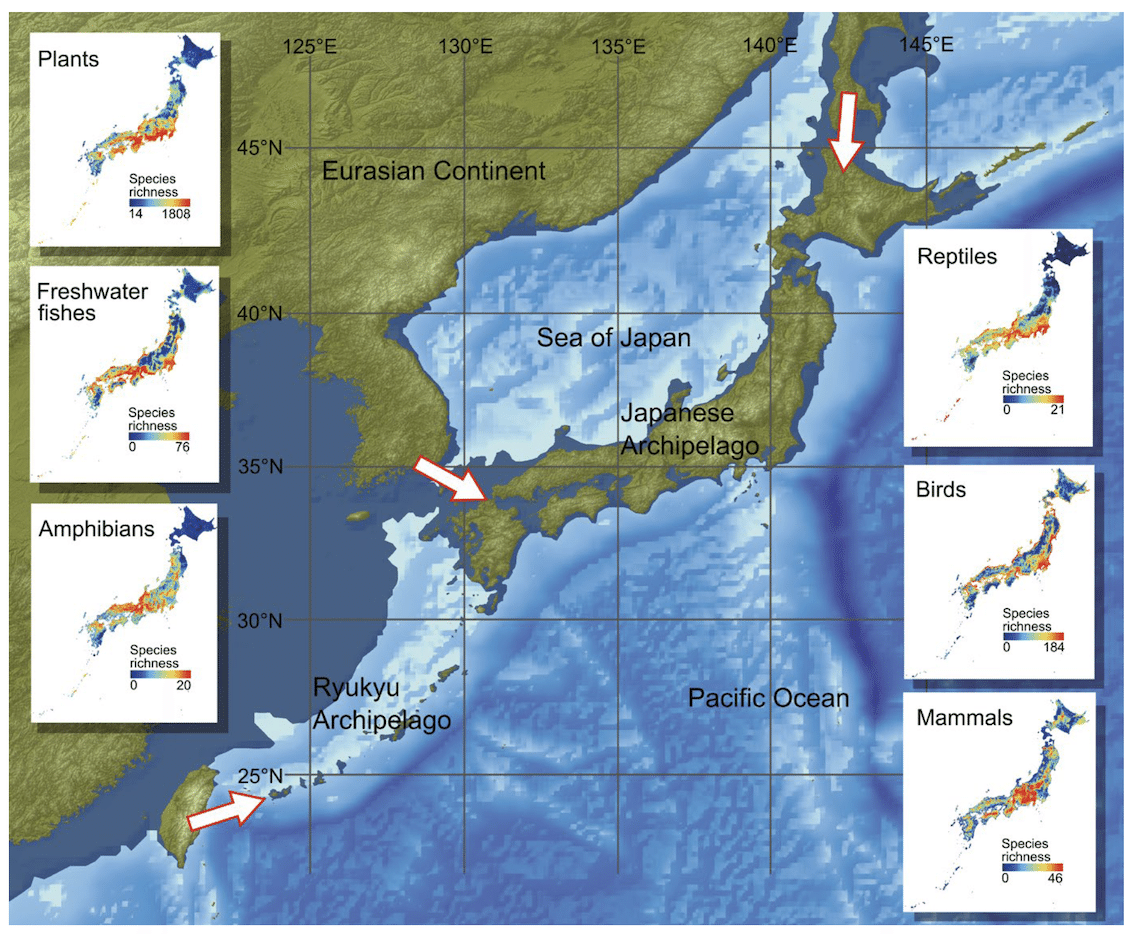

Biodiversity in Japan: hotspots and priority areas for conservation
J-BMP: Japan Biodiversity Mapping Project
Browse the map information of various biodiversity features!
https://biodiversity-map.thinknature-japan.com/en/
Also take a look at the YouTube “How to use the J-BMP”.
Japan is an area that is receiving worldwide attention as a biodiversity hotspot. About 5600 species of vascular plants (ferns, herbs and trees) are distributed in Japan, and 30% of them are endemic.
Conservation International defines biodiversity hotspots in areas where more than 1500 species of endemic vascular plants are distributed and where more than 70% of the native ecosystem has been modified.
https://www.conservation.org/priorities/biodiversity-hotspots
The East Asian islands including the Japanese archipelago, the Ryukyu Islands and the Ogasawara Islands is one of 34 biodiversity hot spots in the world.
Biogeography and macroecology researches reveal that Japan’s biodiversity pattern is a historical product shaped through a combination of climate, geography and geohistory.
Spatial patterns of species richness surprisingly differ among plants, mammals, birds, reptiles, amphibians and freshwater fishes.

These taxon-specific species richness patterns reflect evolutionary and ecological diversifications in relation to the past land-bridge connection, climate changes and topographic heterogeneity etc.
To implement conservation planning, mapping individual species is critically important. If people can know what kind of organisms live in the area where they live, understanding of biodiversity will deepen.
This project visualizes the biodiversity characteristics of Japan’s 47 prefectures and disseminate scientific information related to conservation and use.
Moreover, we identified priority areas for expansion of the existing protected areas network in Japan, as the following way (Lehtomäki and Kusumoto et al. 2018).

In the series of articles listed below, we will inform the analysis results regarding the conservation and utilization plans of biodiversity in 47 prefectures. So far, conservation card for each region is only a very brief explanation in Japanese, but we are going to prepare English version articles. Please see the following as well.
Okinawa
Hokkaido
https://note.com/thinknature/n/n9a5893f9d4e2
Aomori
https://note.com/thinknature/n/nd664b7fe033a
Iwate
https://note.com/thinknature/n/n9446e6fd3fc6
Miyagi
https://note.com/thinknature/n/n9258349fdda4
Akita
https://note.com/thinknature/n/ncce88ea062ab
Yamagata
https://note.com/thinknature/n/n9263ff7fc15f
Fukushima
https://note.com/thinknature/n/n18fe1638450d
Ibaraki
https://note.com/thinknature/n/n1af3a75e866f
Tochigi
https://note.com/thinknature/n/n3634c2c1dbc3
Gunma
https://note.com/thinknature/n/n681df0e4f01c
Saitama
https://note.com/thinknature/n/nb3ad4165fa06
Chiba
https://note.com/thinknature/n/nf2e535467ae7
Tokyo
https://note.com/thinknature/n/nf437a71fe1ed
Kanagawa
https://note.com/thinknature/n/nc3b6d7741e54
Niigata
https://note.com/thinknature/n/nf702bda9881e
Toyama
https://note.com/thinknature/n/nc9ddfd0beaf9
Ishikawa
https://note.com/thinknature/n/n74f368cb8a77
Fukui
https://note.com/thinknature/n/nd86bf60f2ae8
Yamanashi
https://note.com/thinknature/n/nd9d133223f49
Nagano
https://note.com/thinknature/n/ne2ce3776767c
Gifu
https://note.com/thinknature/n/ne77060efeb6b
Shizuoka
https://note.com/thinknature/n/n0a64b789e350
Aichi
https://note.com/thinknature/n/na9bc3699e87b
Mie
https://note.com/thinknature/n/na377127b7738
Shiga
https://note.com/thinknature/n/ne8398216e6f3
Kyoto
https://note.com/thinknature/n/n6b2735960d2e
Osaka
https://note.com/thinknature/n/n9dd088f52bb5
Hyogo
https://note.com/thinknature/n/n7458f0b0facc
Nara
https://note.com/thinknature/n/n06bab18f4bd9
Wakayama
https://note.com/thinknature/n/n6679ebb91b34
Tottori
https://note.com/thinknature/n/nae194dd21edf
Shimane
https://note.com/thinknature/n/n0325aa60e4f4
Okayama
https://note.com/thinknature/n/ne0aa2da0e83f
Hiroshima
https://note.com/thinknature/n/ne9ef55868157
Yamaguchi
https://note.com/thinknature/n/naf202fc43f59
Tokushima
https://note.com/thinknature/n/n912bd0c32c34
Kagawa
https://note.com/thinknature/n/n1ff64c849936
Ehime
https://note.com/thinknature/n/n323cabfa2d9b
Kochi
https://note.com/thinknature/n/n75527041242a
Fukuoka
https://note.com/thinknature/n/n2abe88ecb901
Saga
https://note.com/thinknature/n/n010c08d0d98e
Nagasaki
https://note.com/thinknature/n/n35fe39b59bad
Kumamoto
https://note.com/thinknature/n/nc52b9840f5d2
Oita
https://note.com/thinknature/n/ne4822475e317
Miyazaki
https://note.com/thinknature/n/n42497616e7c7
Kagoshima
https://note.com/thinknature/n/n95f1fcfba737
References and related projects
Literature related to the creation of biodiversity maps is shown in each article. We will continue the revision it in the future, and also list the literature related to geography, geology, and climate of each region that is likely to be related to biodiversity.

